An Experimental and Numerical Analysis of Glued Laminated Beams Strengthened by Pre-Stressed Basalt Fibre-Reinforced Polymer Bars
Abstract
:1. Introduction
2. Materials and Methods
2.1. Materials
2.2. Methods
3. Results and Discussion
3.1. Failure Damage Images of Glued Laminated Beams
3.2. Load-Deflection Curves
3.3. Stress Distribution of Wood and BFRP
3.4. The Numerical Analysis of Glued Laminated Timber Beams
4. Conclusions
- (1)
- The strengthening of timber beams with NSM BFRP bars is an effective method of increasing both the stiffness and the load-bearing capacity of bending timber members. The increase in the ultimate load was 35.88%, while the increase in the stiffness was by up to 23% compared to the unreinforced beams.
- (2)
- It was observed that laminated beams reinforced with bonded BFRP bars both in the tension (with two FRP bars) and compression zones (with one FRP bar) showed a higher increase in the ultimate load capacity, compared to when strengthening was only employed in the tension zone.
- (3)
- The most common failure mode was, for both unreinforced beams and reinforced beams using the NSM BFRP techniques, fibre cracking at wood defects, including the knots in the tension zone. Moreover, it should be noted that some beams showed signs of cracking at the epoxy glue joint.
- (4)
- The results obtained with the finite element method are similar to the experimental results. The slight differences found could be the result of the simplifications used in the numerical model or, on the other hand, the hidden defects of the wood that, for obvious reasons, cannot be included in the numerical simulation.
Author Contributions
Funding
Institutional Review Board Statement
Informed Consent Statement
Data Availability Statement
Conflicts of Interest
References
- Yeboah, D.; Gkantou, M. Investigation of flexural behaviour of structural timber beams strengthened with NSM basalt and glass FRP bars. Structures 2021, 33, 390–405. [Google Scholar] [CrossRef]
- Harte, A.; Crews, K. Reinforcement of timber structures. Constr. Build. Mater. 2015, 97, 1–130. [Google Scholar] [CrossRef]
- Kanócz, J.; Bajzecerová, V.; Šteller, Š. Timber-Concrete Composite Elements with Various Composite Connections Part 1: Screwed connection. Wood Res. 2013, 58, 555–570. [Google Scholar]
- Kanócz, J.; Bajzecerová, V.; Šteller, Š. Timber-Concrete Composite Elements with Various Composite Connections Part 2: Grooved connection. Wood Res. 2014, 59, 627–638. [Google Scholar]
- Kanócz, J.; Bajzecerová, V. Timber-Concrete Composite Elements with Various Composite Connections Part 3: Adhesive connection. Wood Res. 2015, 60, 939–952. [Google Scholar]
- Raftery, G.M.; Kelly, F. Basalt FRP rods for reinforcement and repair of timber. Compos. Part B Eng. 2015, 70, 9–19. [Google Scholar] [CrossRef]
- Usman, A.P.; Sugiri, S. Analysis of the strength of timber and glulam timber beams with steel reinforcement. J. Eng. Technol. Sci. 2015, 47, 601–611. [Google Scholar] [CrossRef]
- Ramesh, M.; Palanikumar, K.; Reddy, H.K. Plant Fibre Based Bio-Composites: Sustainable and Renewable Green Materials. Renew. Sustain. Energy Rev. 2017, 79, 558–584. [Google Scholar]
- Gupta, M.K.; Ramesh, M.; Sabu, T. Effect of Hybridization on Properties of Natural and Synthetic Fiber-Reinforced Polymer Composites (2001–2020): A Review. Polym. Compos. 2021, 42, 4981–5010. [Google Scholar] [CrossRef]
- Yusof, A. Ductility of Timber Beams Strengthened Using Fiber Reinforced Polymer. J. Civ. Eng. Archit. 2013, 7, 535–544. [Google Scholar] [CrossRef] [Green Version]
- Amran, Y.M.; Alyousef, R.; Rashid, R.S.; Alabduljabbar, H.; Hung, C.C. Properties and applications of FRP in strengthening RC structures: A review. Structures 2018, 16, 208–238. [Google Scholar]
- Sonnenschein, R.; Gajdosova, K.; Holly, I. FRP Composites and their Using in the Construction of Bridges. Procedia Eng. 2016, 161, 477–482. [Google Scholar]
- Fiorelli, J.; Dias, A.A. Glulam beams reinforced with FRP externally-bonded: Theoretical and experimental evaluation. Mater. Struct. 2011, 44, 1431–1440. [Google Scholar]
- Corradi, M.; Vo, T.P.; Poologanathan, K.; Osofero, A.I. Flexural behaviour of hardwood and softwood beams with mechanically connected GFRP plates. Compos. Struct. 2021, 206, 610–620. [Google Scholar]
- Ling, Z.; Liu, W.; Shao, J. Experimental and theoretical investigation on shear behavior of small-scale timber beams strengthened with Fiber-Reinforced Polymer composites. Compos. Struct. 2020, 240, 111989. [Google Scholar]
- De Lorenzis, L.; Teng, J.G. Near-surface mounted FRP reinforcement: An emerging technique for strengthening structures. Compos. Part B Eng. 2007, 38, 119–143. [Google Scholar]
- Szabó, Z.K.; Balázs, G.L. Near surface mounted FRP reinforcement for strengthening of concrete structures. Period. Polytech. Civ. Eng. 2007, 51, 33–38. [Google Scholar] [CrossRef] [Green Version]
- Gand, A.K.; Yeboah, D.; Khorami, M.; Olubanwo, A.O.; Lumor, R. Behaviour of strengthened timber beams using near surface mounted Basalt Fibre Reinforced Polymer (BFRP) rebars. Eng. Solid Mech. 2018, 6, 341–352. [Google Scholar] [CrossRef]
- Hollaway, L.C. Fibre-reinfored polymer (FRP) composites used in rehabilitation. In Strengthening and Rehabilitation of Civil Infrastructures Using Fibre-Reinforced Polymer (FRP) Composites, 1st ed.; Hollaway, L.C., Teng, J.G., Eds.; Woodhead Publishing: Sawston, UK, 2008; pp. 45–82. [Google Scholar]
- Wdowiak, A.; Brol, J. Effectiveness of Reinforcing Bent Non-Uniform Pre-Stressed Glulam Beams with Basalt Fibre Reinforced Polymers Rods. Materials 2019, 12, 3141. [Google Scholar]
- Brol, J.; Wdowiak-Postulak, A. Old Timber Reinforcement with FRPs. Materials 2019, 12, 4197. [Google Scholar]
- Brol, J.; Wdowiak, A. The Use of Glass and Aramid Fibres for the Strengthening of Timber Structures. Ann. Wars. Univ. Life Sci. For. Wood Technol. 2017, 100, 128–138. [Google Scholar]
- Brol, J.; Nowak, T.; Wdowiak, A. Numerical Analysis and Modelling of Timber Elements Strengthened with FRP Materials. Ann. Wars. Univ. Life Sci. For. Wood Technol. 2018, 104, 274–282. [Google Scholar]
- Wdowiak, A. Analysis of bent timber beam reinforcement with the application of composite materials. Struct. Environ. 2016, 8, 10–16. [Google Scholar]
- Wdowiak, A. Właściwości Strukturalno—Wytrzymałościowe Zginanych Belek Drewnianych Wzmocnionych Kompozytami Włóknistymi [Structural and Strength Properties of Bent Wooden Beams Reinforced with Fibre Composites]. Ph.D. Thesis, Kielce University of Technology, Kielce, Poland, 12 April 2019. [Google Scholar]
- Wdowiak, A.; Kroner, A. Wpływ niejednorodności struktury zginanych belek z drewna klejonego na efekt ich wzmocnienia. Mater. Bud. 2017, 1, 87–89. [Google Scholar] [CrossRef]
- Wdowiak, A.; Brol, J. Methods of strength grading of structural timber—Comparative analysis of visual and machine grad-ing on the example of Scots pine timber from four natural forest regions of Poland. Struct. Environ. 2019, 11, 210–224. [Google Scholar]
- Wdowiak-Postulak, A.; Świt, G. Behavior of Glulam Beams Strengthened in bending with BFRP Fabrics. Civ. Environ. Eng. Rep. 2021, 31, 1–14. [Google Scholar]
- Kamionka, L.; Wdowiak-Postulak, A.; Hajdenrajch, A. Nowoczesne budownictwo drewniane w technologii CLT na przykładzie budynku Bioklimatycznej Jednostki Modularnej. Mater. Bud. 2022, 1, 51–53. [Google Scholar] [CrossRef]
- Wdowiak-Postulak, A. Basalt Fibre Reinforcement of Bent Heterogeneous Glued Laminated Beams. Materials 2020, 14, 51. [Google Scholar]
- Wdowiak-Postulak, A. Natural Fibre as Reinforcement for Vintage Wood. Materials 2020, 13, 4799. [Google Scholar]
- Wdowiak-Postulak, A.; Brol, J. Ductility of the Tensile Zone in Bent Wooden Beams Strengthened with CFRP Materials. Materials 2020, 13, 5451. [Google Scholar] [CrossRef]
- Wdowiak-Postulak, A. Ductility, load capacity and bending stiffness of Scandinavian pine beams from waste timber strengthened with jute fibres. Drewno 2022, 65, 210. [Google Scholar]
- Wdowiak-Postulak, A. Strengthening of Structural Flexural Glued Laminated Beams of Ashlar with Cords and Carbon Laminates. Materials 2022, 15, 8303. [Google Scholar] [CrossRef]
- Wdowiak-Postulak, A. Numerical, theoretical and experimental models of the static performance of timber beams reinforced with steel, basalt and glass pre-stressed bars. Compos. Struct. 2023, 305, 116479. [Google Scholar] [CrossRef]
- Dempsey, D.D.; Scott, D.W. Wood members strengthened with mechanically fastened FRP strips. J. Compos. Constr. 2006, 10, 392–398. [Google Scholar] [CrossRef]
- Crocombe, A. Stress analysis. In Adhesive Bonding: Science, Technology and Applications, 1st ed.; Adams, R.D., Ed.; Woodhead Publishing: Sawston, UK, 2005; pp. 91–122. [Google Scholar]
- Bank, L.C. Composites for Construction: Structural Design with FRP Materials, 1st ed.; John Wiley and Sons: Hoboken, NJ, USA, 2006; 560p. [Google Scholar]
- Subramanian, N. Sustainability of RCC structures using basalt composite rebars. Masterbuilder 2010, 12, 156–164. [Google Scholar]
- Zhishen, W.; Xin, W.; Gang, W. Advancement of structural safety and sustainability with basalt fiber reinforced polymers. In Proceedings of the 6th International Conference on FRP Composites in Civil Engineering, CICE 2012, Rome, Italy, 13 June 2012. [Google Scholar]
- Dal Lago, B.; Taylor, S.E.; Deegan, P.; Ferrara, L.; Sonebi, M.; Crosset, P.; Pattarini, A. Full-scale testing and numerical analysis of a precast fibre reinforced self-compacting concrete slab pre-stressed with basalt fibre reinforced polymer bars. Compos. Part B: Eng. 2017, 128, 120–133. [Google Scholar] [CrossRef] [Green Version]
- Yeboah, D.; Taylor, S.; McPolin, D.; Gilfillan, R. Pull-out behaviour of axially loaded Basalt Fibre Reinforced Polymer (BFRP) rods bonded perpendicular to the grain of glulam elements. Constr. Build. Mater. 2013, 38, 962–969. [Google Scholar] [CrossRef] [Green Version]
- Taylor, S.; Robinson, D.; Sonebi, M. Basalt-fibre-reinforced polymer reinforcement. Concr. Camberley 2011, 45, 48–50. [Google Scholar]
- Asplund, S.O. Strengthening bridge slabs with grouted reinforcement. J. Proc. 1949, 45, 397–406. [Google Scholar]
- Kraľovanec, J.; Bahleda, F.; Moravcik, M. State of Prestressing Analysis of 62-Year-Old Bridge. Materials 2022, 15, 3583. [Google Scholar] [CrossRef]
- Kraľovanec, J.; Moravčík, M.; Jošt, J. Analysis of Prestressing in Precast Prestressed Concrete Beams. Civ. Environ. Eng. 2021, 17, 184–191. [Google Scholar] [CrossRef]
- Bahleda, F.; Drevený, I.; Pitoňák, M.; Neslušan, M. Employment of Barkhausen Noise Technique for Assessment of Prestressing Bars Damage with Respect of Their Over-Stressing. Met. Open Access Metall. J. 2021, 11, 770. [Google Scholar] [CrossRef]
- Fossetti, M.; Minafò, G.; Papia, M. Flexural behaviour of glulam timber beams reinforced with FRP cords. Constr. Build. Mater. 2015, 95, 54–64. [Google Scholar] [CrossRef]
- McConnell, E.; McPolin, D.; Taylor, S. Post-tensioning of glulam timber with BFRP tendons. Constr. Build. Mater. 2014, 73, 1–9. [Google Scholar] [CrossRef] [Green Version]
- De Lorenzis, L. Strengthening of RC Structures with Near Surface Mounted FRP Rods. Ph.D. Thesis, Department of Innovation Engineering, University of Lecce, Lecce, Italy, 2002. [Google Scholar]
- Xian, G.; Guo, R.; Li, C.; Wang, Y. Mechanical Performance Evolution and Life Prediction of Prestressed CFRP Plate Exposed to Hygrothermal and Freeze-Thaw Environments. Compos. Struct. 2022, 293, 115719. [Google Scholar] [CrossRef]
- Heydarinouri, H.; Vidovic, A.; Nussbaumer, A.; Ghafoori, E. FE Analysis and Experimental Validation of Mechanical Wedge-barrel Anchors for CFRP Rods. Compos. Struct. 2021, 275, 114509. [Google Scholar] [CrossRef]
- Guo, R.; Li, C.; Xian, G. Water Absorption and Long-term Thermal and Mechanical Properties of Carbon/Glass Hybrid Rod for Bridge Cable. Eng. Struct. 2023, 274, 115176. [Google Scholar] [CrossRef]
- Pavlovič, A.; Donchev, T.; Petkova, D. Experimental Monitoring of Long-Term Structural Behaviour and Prestress Losses of BFRP Pretensioned Beams Under Sustained Loading. In Proceedings of the 10th International Conference on FRP Composites in Civil Engineering (CICE 2020/2021), Istanbul, Turkey, 8 December 2021. [Google Scholar]
- Pearson, M.; Donchev, T.; Salazar, J. Long-Term Behaviour of prestressed Basalt Fibre Reinforced Polymer Bars. Procedia Eng. 2013, 54, 261–269. [Google Scholar] [CrossRef] [Green Version]
- PN-EN 14080:2013-07; Timber Structures—Glued Laminated Timber and Glued Solid Timber—Requirements. Polish Committee for Standardization: Warsaw, Poland, 2013.
- PN-D-94021:2013-10; Softwood Structural Sawn Timber Sorted Using Strength Methods. Polish Committee for Standardization: Warsaw, Poland, 2013.
- PN-EN 338:2016-06; Structural Timber—Strength Classes. Polish Committee for Standardization: Warsaw, Poland, 2016.
- PN-EN 408+A1:2012; Timber Structures—Structural Timber and Glued Laminated Timber—Determination of Some Physical and Mechanical Properties. Polish Committee for Standardization: Warsaw, Poland, 2012.
- PN-EN 1995-1-1:2010 Eurocode 5; Design of Timber Structures. Part 1-1: General. Common Rules and Rules for Buildings. Polish Standards Committee: Warsaw, Poland, 2010.

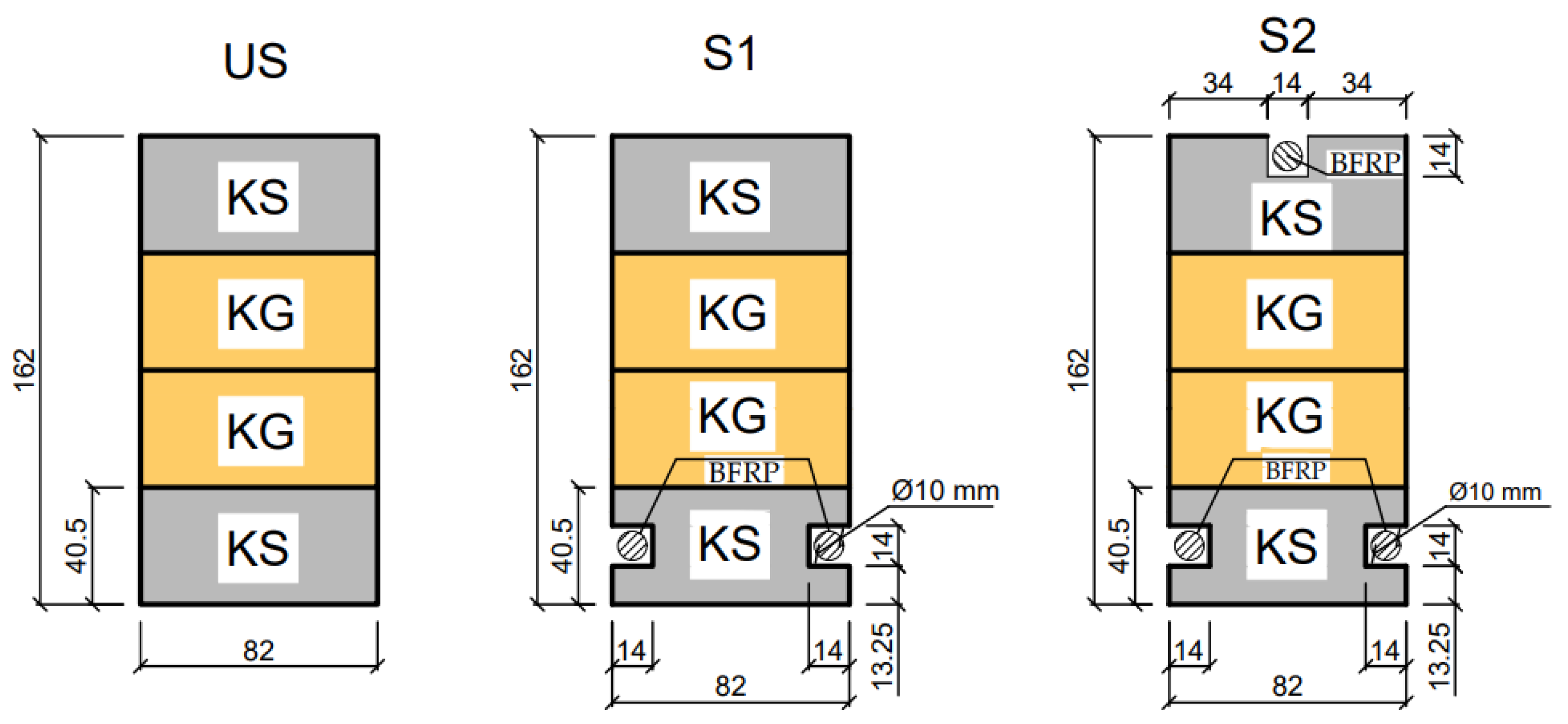
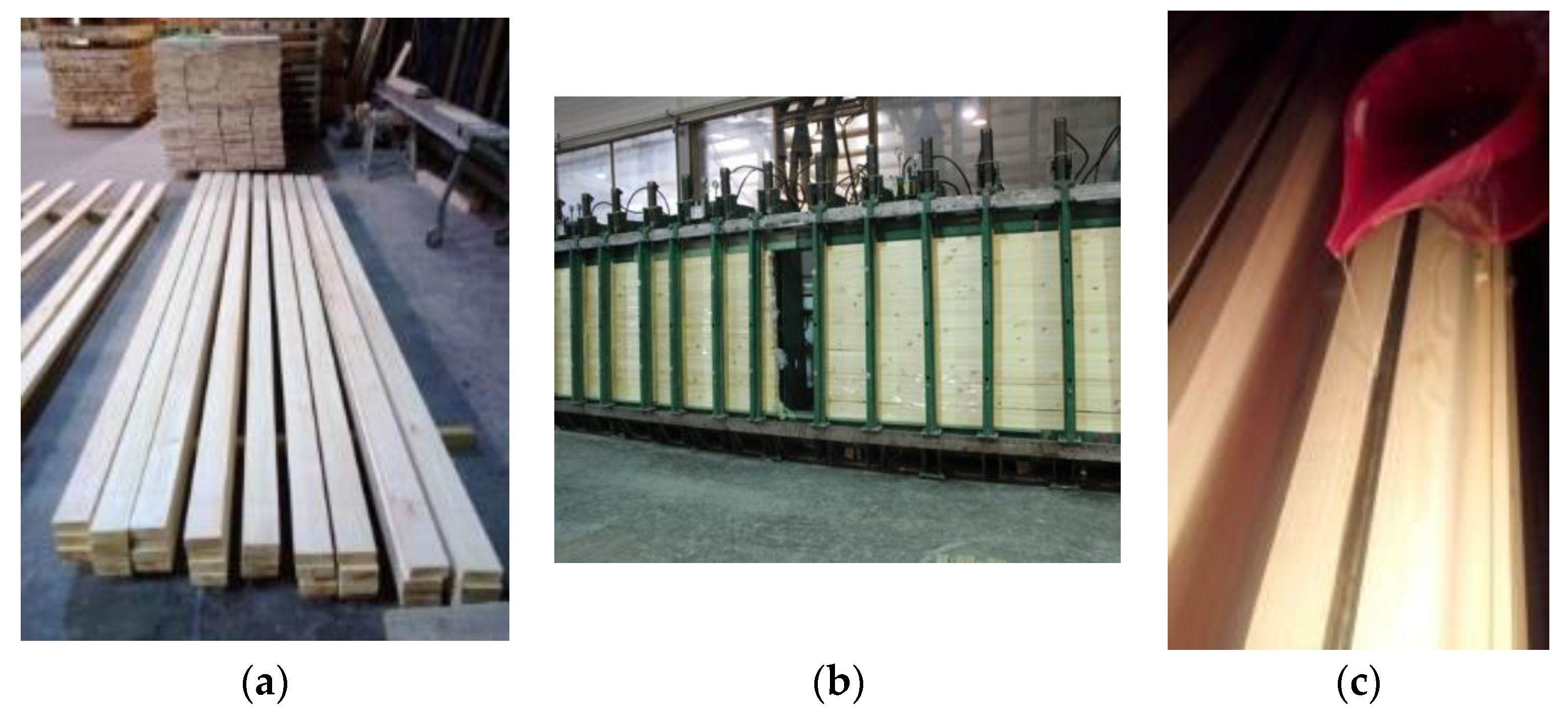
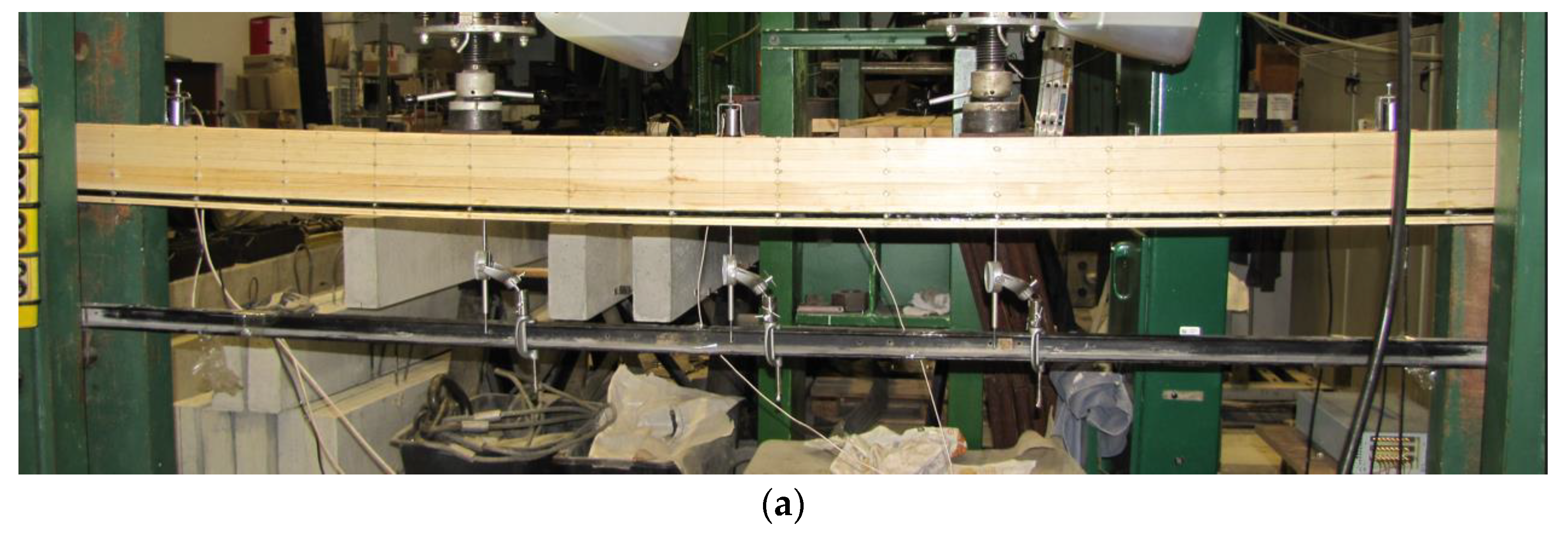
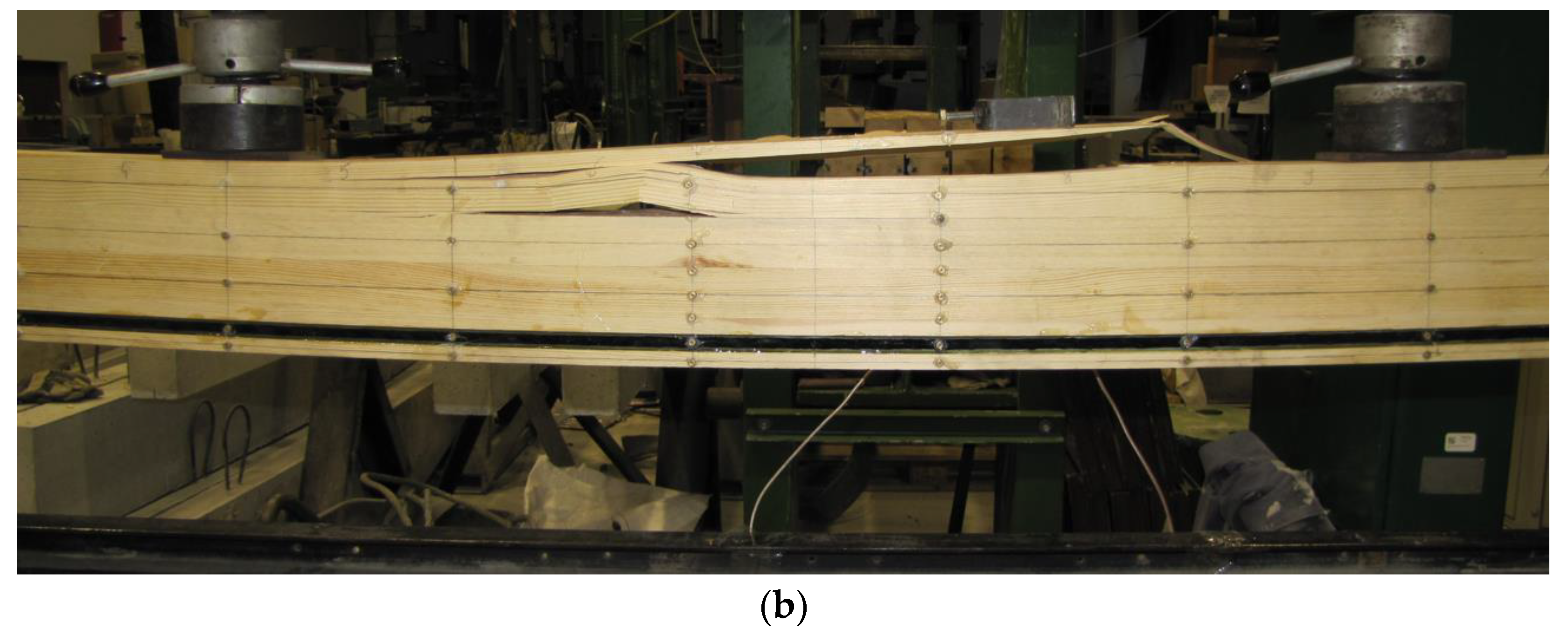
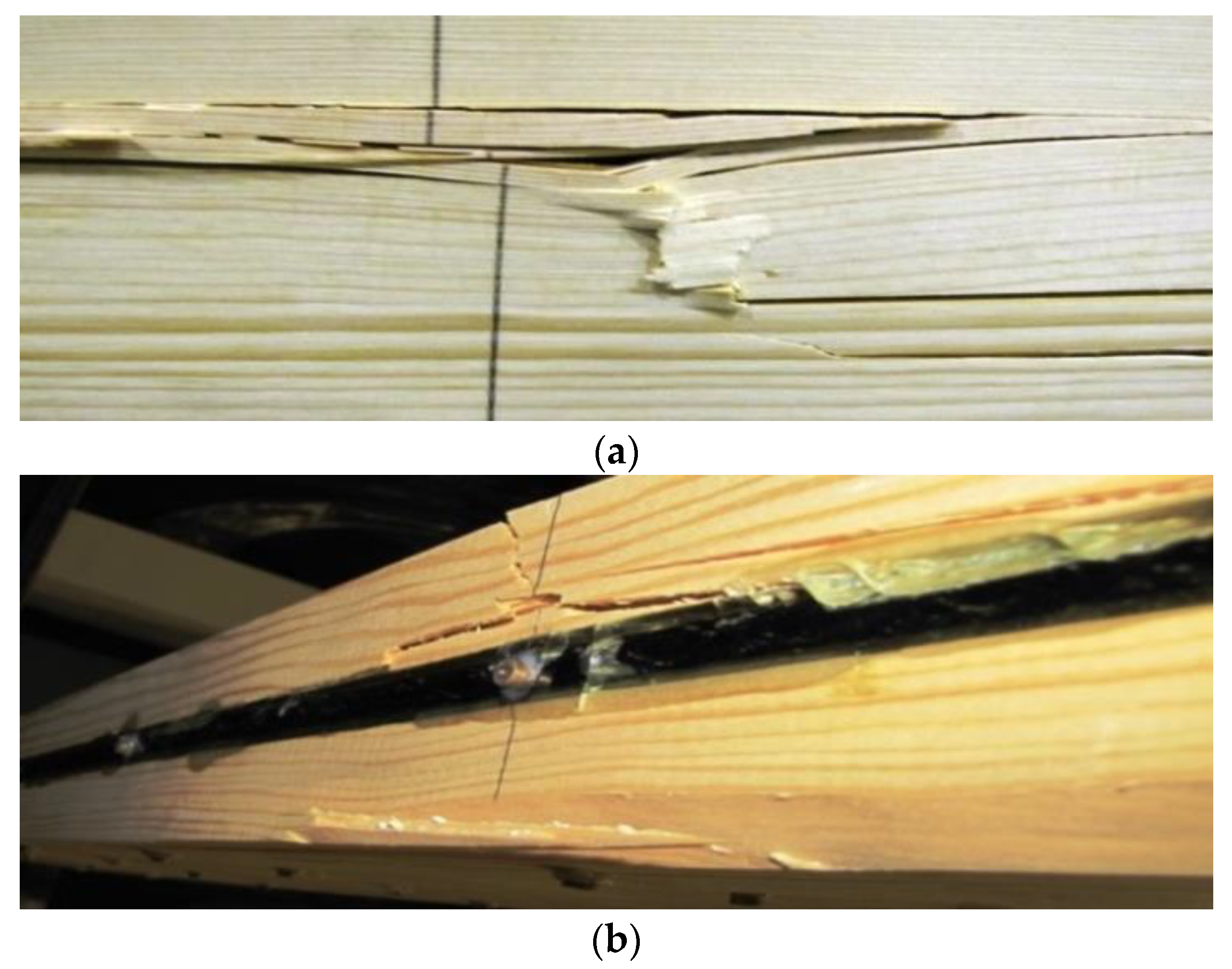

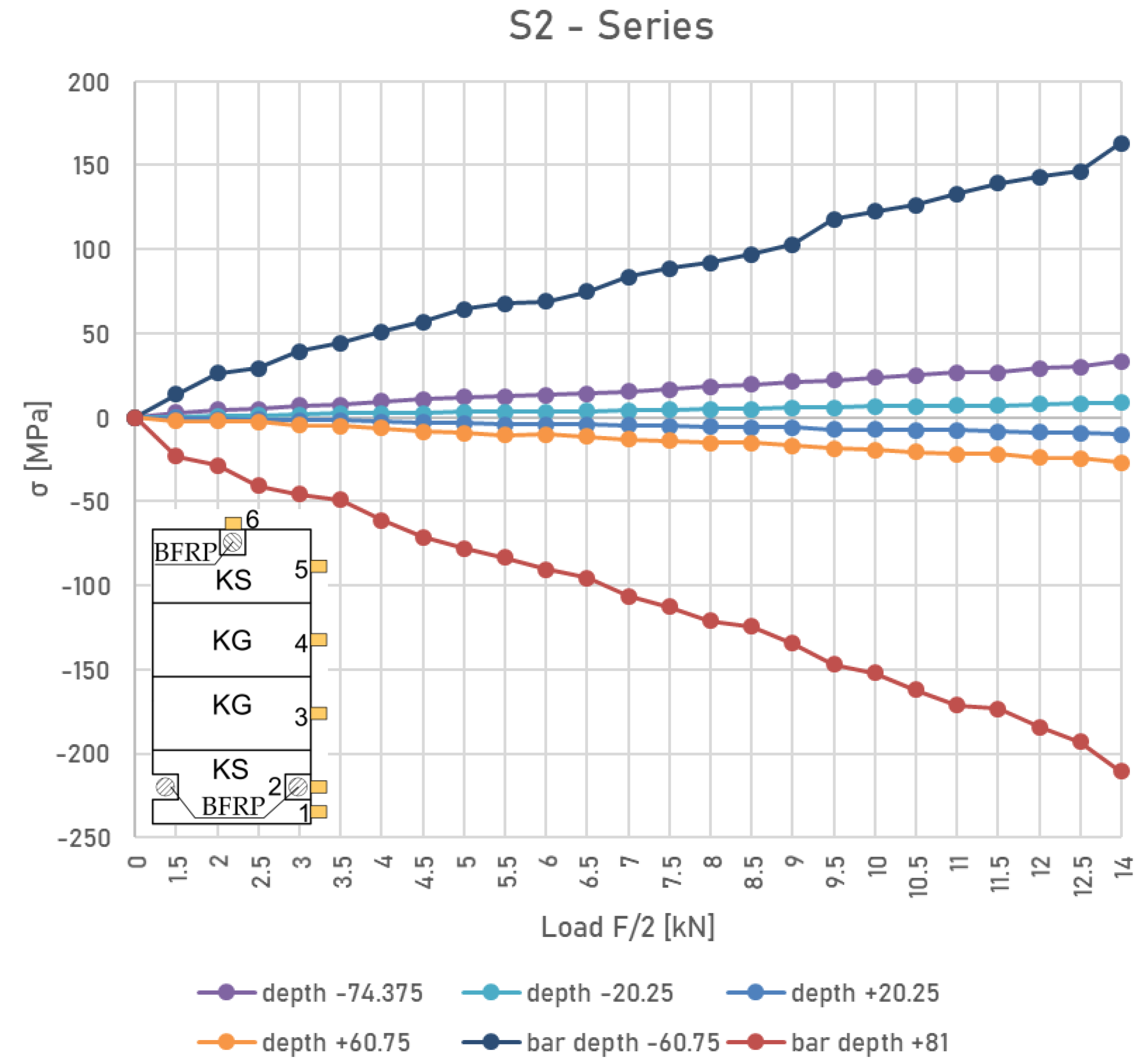
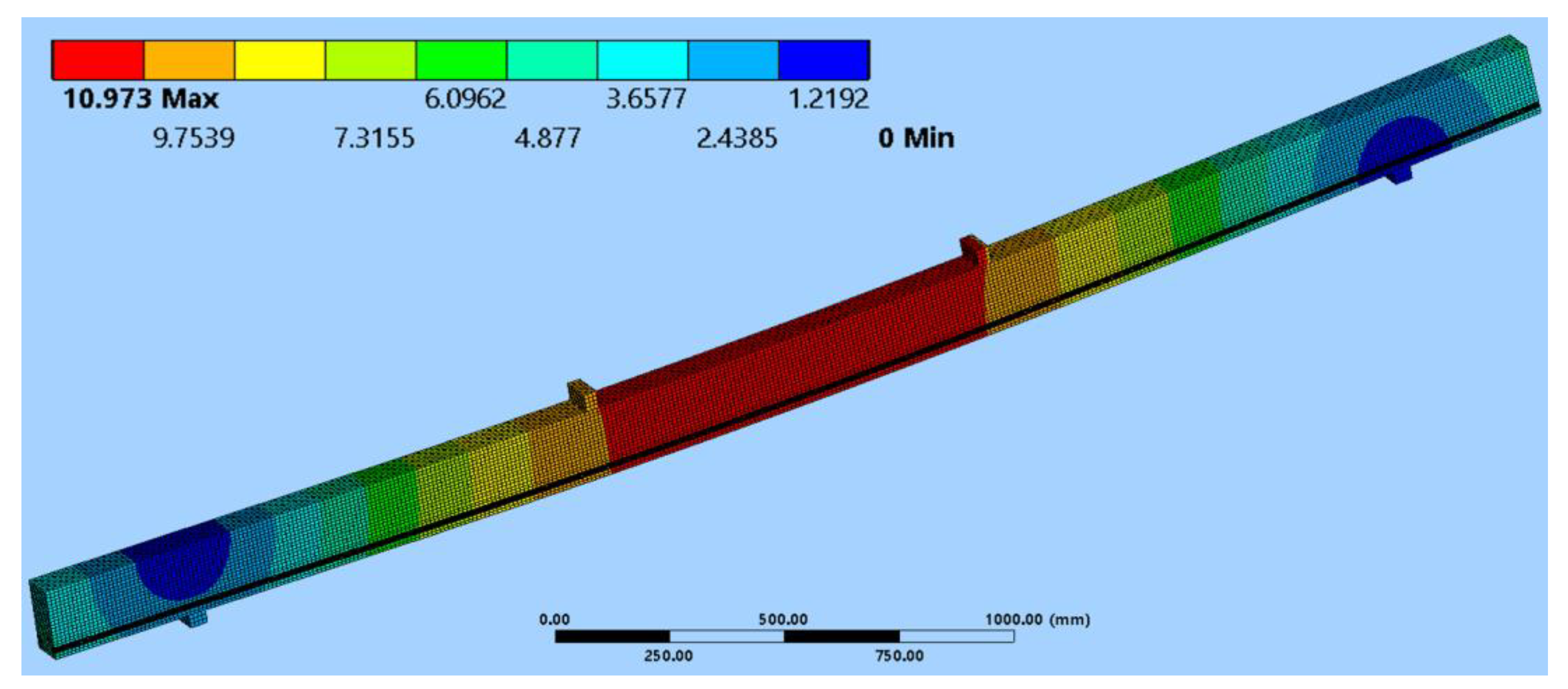
| Material | Tensile Strength (N/mm2) | Compressive Strength (N/mm2) | Bending Strength (N/mm2) | Shear Strength (N/mm2) | Modulus of Elasticity (N/mm2) |
|---|---|---|---|---|---|
| Timber | 17 | 21.5 | 24 | 3.5 | 11,000 |
| The Failure Load F [kN] | Beam | Average Resistance | Description of the Damage |
|---|---|---|---|
| 44 | US1 | 43.2 | Shearing of the adhesive bond in the tensile zone and subsequent displacement of the tensile lamellas. |
| 39 | US2 | The failure occurred at the site of a hidden wood defect—a knot. | |
| 47 | US3 | Delamination of the tensioned lamella at a force of 47 kN, then shearing of the wood along the fibres. | |
| 45 | US4 | Damage to the tension lamellae through the fracture of the tension lumber fibres. | |
| 41 | US5 | Tearing of the wood fibres appeared in the tension lamella, followed by failure in the compression zone due to the present knot. | |
| The failure load F [kN] | Beam | Resistance increase [%] | Description of the damage |
| 51 | S11 | 18.1 | The failure occurred initially in the area of the defect—a knot, at the centre of the beam span. |
| 55 | S12 | 27.3 | A hidden defect—a knot—appeared in the middle of the span. This was followed by the detachment of the epoxy glue from the rebar. |
| 55 | S13 | 27.3 | The failure occurred initially in the area of the defect—a knot, at the centre of the beam span. |
| 57 | S14 | 31.9 | In the tensile zone, a shear of the glue joint appeared at first, followed by a displacement of the tensile lamella. |
| 51 | S15 | 18.1 | Peeling was observed between the bars and the timber in the tensile zone of the beams when the failure load was reached. |
| 63 | S21 | 45.8 | Damage in the tensile zone in place of a hidden defect (knot), followed by crushing in the compression zone. |
| 67 | S22 | 55.1 | Separation of epoxy adhesive from the wood occurred in the vicinity of the knot of the tension zone, followed by crushing in the compression zone. |
| 60 | S23 | 38.9 | The failure was due to fracture in the compression and tension zones. |
| 64 | S24 | 48.2 | Cracking of the wood fibres in the tension zone, then compression. Peeling was observed between the bars and the wood. |
| 64 | S25 | 48.2 | Shearing of the compression zone, followed by spalling of the wood and epoxy glue in the tension zone. |
| Type of Wood | Young’s Modulus (MPa) | Poisson’s Ratio | Shear Modulus (MPa) | ||||||
|---|---|---|---|---|---|---|---|---|---|
| X | Y | Z | X | Y | Z | XY | YZ | XZ | |
| Lamella KS | 11,000 | 363 | 363 | 0.54 | 0.027 | 0.54 | 690 | 69 | 690 |
| Lamella KG | 7000 | 230 | 230 | 0.54 | 0.027 | 0.54 | 440 | 44 | 440 |
| Type of Bar | Young’s Modulus (MPa) | Tensile Strength (MPa) | Compressive Strength (MPa) | Elongation at Rupture [%] |
|---|---|---|---|---|
| BFRP | 56,300 | 1455.3 | 945.9 | 2.12 |
| Type of Material | Young’s Modulus (MPa) | Tensile Strength (MPa) | Compressive Strength (MPa) | Elongation at Rupture [%] |
|---|---|---|---|---|
| Epoxy glue | 3000 | 80 | 140 | 6 |
| Series | Experimental Analysis—Mean Value | Numerical Analysis | Difference |
|---|---|---|---|
| u [mm] | u [mm] | [%] | |
| US | 16.23 | 15.12 | 6.84 |
| S1 | 11.62 | 10.97 | 5.59 |
| S2 | 10.16 | 9.67 | 4.82 |
Disclaimer/Publisher’s Note: The statements, opinions and data contained in all publications are solely those of the individual author(s) and contributor(s) and not of MDPI and/or the editor(s). MDPI and/or the editor(s) disclaim responsibility for any injury to people or property resulting from any ideas, methods, instructions or products referred to in the content. |
© 2023 by the authors. Licensee MDPI, Basel, Switzerland. This article is an open access article distributed under the terms and conditions of the Creative Commons Attribution (CC BY) license (https://creativecommons.org/licenses/by/4.0/).
Share and Cite
Wdowiak-Postulak, A.; Bahleda, F.; Prokop, J. An Experimental and Numerical Analysis of Glued Laminated Beams Strengthened by Pre-Stressed Basalt Fibre-Reinforced Polymer Bars. Materials 2023, 16, 2776. https://doi.org/10.3390/ma16072776
Wdowiak-Postulak A, Bahleda F, Prokop J. An Experimental and Numerical Analysis of Glued Laminated Beams Strengthened by Pre-Stressed Basalt Fibre-Reinforced Polymer Bars. Materials. 2023; 16(7):2776. https://doi.org/10.3390/ma16072776
Chicago/Turabian StyleWdowiak-Postulak, Agnieszka, František Bahleda, and Jozef Prokop. 2023. "An Experimental and Numerical Analysis of Glued Laminated Beams Strengthened by Pre-Stressed Basalt Fibre-Reinforced Polymer Bars" Materials 16, no. 7: 2776. https://doi.org/10.3390/ma16072776





